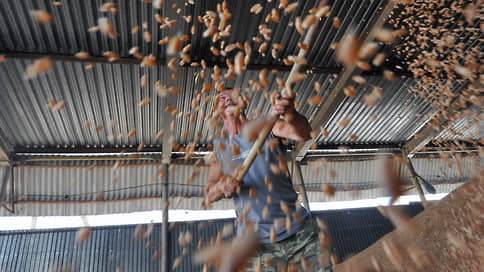The grain will work with gas – Newspaper Kommersant No. 46 (7491) of 03/20/2023
[ad_1]

The Ministry of Agriculture has published a new scheme for trade in Russian grain on the world market, it practically repeats the rules by which Russia trades gas with the EU. Foreign trade operations of the grain market are proposed to be serviced by one bank – the National Clearing Center (NCC), which will convert foreign currency payments of buyers on the exchange and settle accounts with agricultural producers on their behalf. De facto, we are talking about replicating a scheme that protected payments for gas supplies from the sanctions of developed countries – if they are extended to the NCC, grain shipments from the Russian Federation will be completely stopped, which, with plans to export 55-60 million tons of grain per year (more than $ 15 billion) will create a deficit in the world market. At the same time, the scheme will require exemption from sanctions pressure of payments for Russian agricultural exports only through the NCC, which will simplify the execution by the UN of the Russian part of the grain deal. Market participants, however, doubt that there is sufficient demand in the Russian Federation for the currencies of buyers of its grain.
The Ministry of Agriculture proposes to approve a new scheme for foreign trade in agricultural products – a draft presidential decree on it has been published on regulation.gov.ru. Buyers will be able to make settlements for Russian grain through one authorized bank – the National Clearing Center: for such purposes, it will open special ruble and currency accounts of type “Z” for foreign buyers. The NCC will convert foreign currency payments at exchange auctions, and the received rubles will be settled on behalf of the buyer with Russian suppliers.
In its structure and content, the published document repeats the “EU gas ultimatum” — Decree No. 172 signed by Vladimir Putin on March 31, 2022 on a new payment scheme for Russian gas supplies. The only significant difference between one document and another is that the “grain” decree in its current form does not formally require the mandatory conversion of settlements into rubles like the “gas” one, but de facto the schemes do not differ.
The idea, apparently, is due to the stability of “gas” payments, combined with the authorities’ dissatisfaction with the execution of the “Russian” part of the grain deal — the process of exempting payments for agricultural exports and logistics from sanctions pressure. In addition to the fact that for the NCC in such conditions the risks of being under sanctions are reduced, as this will stop all export shipments of Russian grain (in 2021, the Russian Federation accounted for the largest share of the world market – 18%, and last week about the need to maintain the grain deal at any cost said the executive director of the UN World Food Program David Beasley), by choosing one authorized bank, the Russian Federation achieves several more goals: for example, it relieves the UN of the need to coordinate the lifting of disparate restrictions on banks through which grain exporters have carried out such transactions so far, and also aggregates in one financial institution all information on foreign trade settlements for grain exports. The document, however, still has to be approved by the Kremlin, the White House (and then within ten days to determine the list of agricultural products to which the new scheme will apply) and the Central Bank. It is likely that the expected terms of approvals are also taken into account in the term for extending the grain deal by only 60 days (on this insists Russian side) – yesterday, the Ministry of Agriculture and the office of Deputy Prime Minister for Agro-industrial Complex Victoria Abramchenko could not answer Kommersant’s questions about this.
It is obvious that, first of all, the grain trade should fall under the new rules: a record harvest in 2022 (157.7 million tons) requires the export of 55-60 million tons to the world market to stabilize domestic prices – at current prices, we are talking about more than $15 billion , or 1.2 trillion rubles, export earnings. During the first half of the agricultural year (July 1-December 31), 32 million tons were shipped, but in reality we are talking about behind schedule: seasonally, these dates account for most of the export.
The forecast published yesterday by the International Grain Council (IGC) estimates shipments of the current agricultural year at 51.8 million tons, which also indicates that shipments are lagging behind the plans of the Ministry of Agriculture. At the same time, the problem will not be a one-time problem: for the 2023/24 agricultural year, the MZS estimates the harvest in the Russian Federation at an excess of 124.3 million tons, and exports at 51 million tons.
In the grain market, Kommersant confirmed that the new scheme was being prepared with the participation of specialized associations. So, according to Eduard Zernin, Chairman of the Board of the Union of Grain Exporters, the organization participated in the development of the mechanism, and the project, unlike the gas trade, introduces an additional mechanism for paying for export deliveries. At the same time, exporters are concerned about the presence in the Russian foreign exchange market of sufficient demand for the currencies of the largest grain buyers from Russia (Egypt, Turkey and Iran), which can create problems with the forced exchange conversion of these funds into rubles and affect the final prices and volumes of such transactions. The market would like to expand trade in grain with “friendly countries” for the Russian currency – by providing them with ruble interstate loans, but the Ministry of Finance opposes this idea, Eduard Zernin told Kommersant. “If the state is not ready, a market mechanism is needed that will supply ruble liquidity to foreign buyers,” insists the head of the exporters’ union.
[ad_2]
Source link






